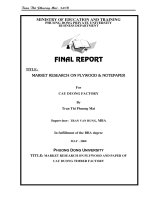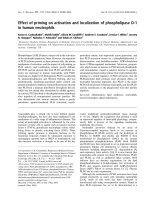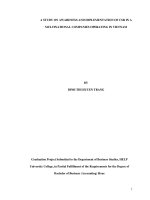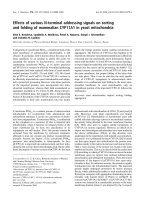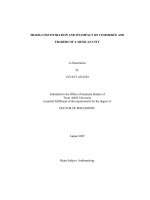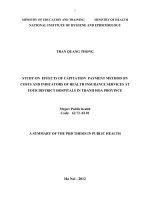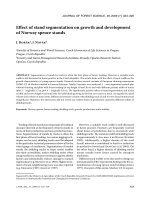Conclusions on Strengths and Weaknesses of Rang Dong Plastic Company
Bạn đang xem bản rút gọn của tài liệu. Xem và tải ngay bản đầy đủ của tài liệu tại đây (370.22 KB, 66 trang )
DEVELOPMENT STRATEGY FOR VIETNAM PLASTIC
INDUSTRY: A CASE STUDY OF RANGDONG PLASTIC COMPANY
by
Ly Thi Minh Chau
A research study submitted in partial fulfillment of the requirements for the
degree of Master of Business Administration
Examination Committee:
Dr. Fredric William Swierczek (Chairman)
Dr. Truong Quang
Dr. Clemens Bechter
Nationality:
Previous Degree:
Vietnamese
Bachelor of Economics
HCMC University of Economics, Vietnam
Bachelor of English
HCMC University of Education, Vietnam
Scholarship Donor:
The Government of Switzerland
Asian Institute of Technology
School of Management
Bangkok, Thailand
April 1999
i
ACKNOWLEDGEMENT
I would like to express my deepest gratitude to my research advisor, Dr. Fredric William
Swierczek for his intensive support, valuable suggestions, guidance and encouragement
during the course of my study.
My sincere thanks are also due to Dr. Truong Quang and Dr. Clemens Bechter for their
valuable time as the members of the examination committee. Their constructive suggestions
were of great help in my completing this study.
I would like to express my sincere gratitude to all of my teachers at SOM-AIT for their
teaching and guidance during my course.
I sincerely thank Mr. Uong Tien Thinh and Mr. Le Dinh Tuc for providing me the
opportunity to carry out the study and such valuable information. I appreciate the assistance
of managers and staff of Rang Dong Plastic Company who were helpful in the collection of
data.
I would like to specially express my thanks to all of my friends for their support and
encouragement.
Finally, I heartily dedicate this study to my beloved parents and my husband, Nguyen Thanh
Long who have always sacrificed to encourage and support me during my study at AIT.
ii
ABSTRACT
Rang Dong Plastic company is one of the most successful companies in terms of high market
share. It has produced plastic products of various kinds in which PVC films is the core
product of the company. The PVC films product accounts for 70% of the market share.
However, in the competitive environment, Rang Dong Plastic company has faced various
difficulties especially the lack of the vision in the long term. The objective of the study will
therefore design a development strategy for the company in the long term.
Based on the examination and analysis of the external and internal environment, the study
will determine strengths, weaknesses, opportunities and threats (SWOT). Derived from the
SWOT and based on the general process of strategy formulation, the study will develop the
most appropriate development strategy for the company. Finally some recommendations are
suggested for the company to be able to implement the proposed strategy.
iii
Table of Contents
Chapter
Title
Page
Title Page
i
ACKNOWLEDGEMENT
ii
ABSTRACT
iii
List of Tables
vii
1 INTRODUCTION
1
1.1 Background
1
1.2 Problem statement
1
1.3 Objectives
1
1.4 Scope and limitations of the study
2
1.5 Methodology and framework of the study
2
1.6 Organization of the study
4
2 LITERATURE REVIEW
5
2.1 Strategic management perspective
5
2.2 Definition of strategy
5
2.3 The process of strategic management
6
2.4 Structural analysis of the competitive environment:
8
2.5 Selecting development strategies
12
3 EXTERNAL ENVIRONMENT ANALYSIS
16
3.1 Macro-environment analysis
16
3.2 Current situation and trend of investment of Plastic Industries in Asian nations.
19
3.3 Current situation of Vietnam plastic industry
22
3.4 Development of Vietnam plastics industry of 2005
25
iv
3.5 Investment potentials
28
3.6 Industry environment analysis
31
3.7 Summary of opportunities and threats for Rang Dong Plastic company
32
4 INTERNAL ENVIRONMENT ANALYSIS
34
4.1 History of Rang Dong plastic company
34
4.2 Company missions
35
4.3 Organizational structure
35
4.4 Production at Rang Dong Plastic company
38
4.5 Sales and net income
45
4.6 Marketing
47
4.7 Finance
49
4.8 Conclusions on strengths and weaknesses of Rang Dong Plastic Company
50
5 DEVELOPMENT STRATEGY DESIGN
51
5.1 Foundations of Rang Dong plastic company’s strategy
51
5.2 Strategic options for Rang Dong plastic company
52
6 CONCLUSION AND RECOMMENDATIONS
55
6.1 Conclusion
55
6.2 Recommendations
56
REFERENCES
58
v
List of Figures
Figure 1.1 - Framework of the Study
3
Figure 2.1 - The Determinants of Company Performance
5
Figure 2.2 - Strategy Formulation Process
7
Figure 2.3 - Requirements for Competitive Success
8
Figure 2.4 - The Five Forces Model
9
Figure 2.5 - The Porter Model Applied for the Vietnam Plastic Industry
12
Figure 2.6 - Development Strategies
13
Figure 3.1 - GDP during the Period of 1990-1998
18
Figure 3.2 - GDP Growth Rate in the Period of 1990-1998
18
Figure 3.4 - Asean Thermoplastics Consumption by Type
21
Figure 3.5 - The Competitors in the Field of Producing PVC Films
32
Figure 4.1 - Rang Dong Plastic Company’s Organizational Chart
36
Figure 4.2 - Process of Producing PVC Films
39
Figure 4.3 - Process of Producing PVC Leathers
40
Figure 4.4 - Process of Producing Sheets for Roofing and PVC, PE Boards
41
Figure 4.5 - Process of Producing Pet Bottles
41
Figure 4.6 - Current Product Structure of Rang Dong Plastic Company
44
Figure 4.7 - Sales Revenue
45
Figure 4.8 - Net Income (1994-1997)
46
Figure 4.9 - Structure of PVC Films Market Share
46
Figure 4.10 - Distribution System of Rang Dong Plastic Company
48
Figure 5.1 - Development Strategy Designed for Rang Dong Plastic Company
54
vi
List of Tables
Table 2.1 – Generic Strategies
14
Table 2.2 – Product / Market / Distinctive Competence - Choice and Generic
Competitive Strategy
14
Table 2.3 – Alternative Directions for Development
15
Table 3.1 – The Economic Growth Rates (%)
20
Table 3.2 – 1997 Asean Per Capita Thermoplastics Consumption
21
Table 3.3 – Plastic Product Structure Compared with Thailand and Malaysia
23
Table 4.1 – Labor Force of Rang Dong Plastic Company
38
Table 4.2 – Price List of PVC Films Products According to Methods of Payment
47
Table 4.3 – Rate between Sales Revenues and Advertising Costs
48
Table 4.4 – Fixed Assets Turnover
49
Table 4.5 – Total Assets Turnover
50
Table 5.1 – Direction for Rang Dong Plastic Company’s Strategy Development
54
vii
CHAPTER 1
1
1.1
INTRODUCTION
Background
In the past 20 years and in the following years, together with the expeditious development of
scientific and technical areas such electronic, communication, biotechnology advance in the
world, the plastics have also had outstanding technological progress. As plastic products in
these days are serving not only for family life activities but in all economic sectors, through
the experience of developing countries it is proven that if the growth ration of the national
economy is 1%, the plastic industry will develop accordingly from 2% to 3%. In the next 10
years, according to a forecast of economic experts, our country's economy can grow stable at
a rate of 7%-8% or more. Therefore, the annual growth rate of the plastic industry will also
be in the range of 20%-25% consequently. The center of the development of the plastic
industry as well as the center of the plastic industry is now concentrated in Ho Chi Minh City
with productivity of over 70% output of the country with plastic products of various kind.
This situation leads to the benefits for consumers and the profit reduction for producers. In
addition, the plastic products serve mainly for consuming household utensils at the rate of
about 65% of the total output. Plastic products for other economic areas are not much,
remarkably are the packaging products covering 20% of the total output, plastic product or
electric and electric industry and for other production industries are very little. The plastic
industry of Vietnam is on the threshold of a new and highly promising but also of the
challenging era of development. Vietnam Plastics industry has gained such a high
development. However, due to the low start, the per capita of 2.8 kg is still not comparable
with that of 100-200 kg per annum in other developed countries. Not only the per capita is
too low but product structure accounts for the low level of Vietnam Plastic industry in
comparison with other countries. Moreover, most of the manufacturers are of small and
medium size and the number of big-sized manufacturers are very few. This situation results
from the lack of the management at the macro level. It is clear that the Vietnam Plastic
Industry needs a development strategy in the long run. This problem will be illustrated more
clearly through the case of Rang Dong Plastic Company.
Rang Dong Plastic Company has faced with various difficulties especially the lack of the
vision and the limitation of information about foreign market and competitors for strategic
management in the long term.
1.2
Problem statement
Based on the examination and analysis the external and internal environment, the study will
formulate the development strategy for the Rang Dong Plastic Company in the long term.
1.3
Objectives
The study is an attempt to establish the development strategy for the Rang Dong Plastic
Company. The following are the specific objectives of the study:
To review literature dealing with the strategic management process, especially the process of
strategy formulation.
1
To identify strengths and weaknesses as well as opportunities and threats that the Rang Dong
Plastic Company has been faced with.
To assess the current situation of the company to develop its competitive profile.
To formulate the development strategy for the Rang Dong Plastic Company in the long term.
1.4
Scope and limitations of the study
The study is about the Rang Dong Plastic Company. It aims at the formulation of the
development strategy for the company in the long term.
The depth of the study depends partly on the availability of the data of Vietnam's economic
situation and plastic industry in general, especially of Rang Dong Company. It depends on
the cooperation from the company and the Vietnam Plastic Association (VINAPLAST) as
well.
1.5
Methodology and framework of the study
The study begins with the literature review which concerns the strategic management
process, particularly the process of strategy formulation. It refers to the concepts and
principles of the Porter Model to analyze the competitive environment of the industry. Data
for the study are collected from 2 main sources:
Primary data: Interviews with by persons of VINAPLAST and the Rang Dong Plastic
Company as well as other plastic companies.
Secondary data: Annual reports and other relevant data about the Rang Dong Plastic
Company. Relevant data about the plastic industry and the Vietnam economy will be
collected from Ministry of Industry, VINAPLAST, the National Statistics Office, Ho Chi
Minh City Statistics Office, Ho Chi Minh Department of Industry and Commerce, from
newspapers, magazines and from Internet and media as well.
The framework of the study can be illustrated by Figure 1.1.
2
PROBLEM
LITERATURE REVIEW
STRATEGY PROCESS
SITUATION ANALYSIS
Scanning
external
environment
Analyzing
competitive
Scanning
internal
environment
Evaluating current
performance results
•
Opportunities
•
Strengths
•
Threats
•
Weaknesses
GENERATION, EVALUATION, AND SELECTION OF THE BEST STRATEGY
CONCLUSIONS AND RECOMMENDATIONS
Figure 1.1 - Framework of the Study
3
1.6
Organization of the study
Chapter 1 presents an introduction including the rationale of the study, and statement, the
objectives, the scope and limitations as well as the methodology and framework of the study.
Chapter 2 summarizes the literature review and contains the fundamental ideas on strategy,
strategic management, strategy formulation process as well as the Porter Model for analyzing
industry.
Chapter 3 provides and analysis of external factors to identify the company's strategic
position as well as strategic orientations and investment opportunities for the Vietnam plastic
industry in the coming years. Based on the Porter model for examining the plastic industry
environment, the opportunities and threats for the Rang Dong plastic company is found out.
Chapter 4 includes the current analysis of the Rang Dong Plastic Company in terms of
organizational structure, production, sales, marketing and finance. The goal is to identify
strengths and weaknesses of the company to depict its current competitive situation.
Chapter 5 presents the design of development strategy for the Rang Dong plastic company.
Finally, Chapter 6 includes recommendations on the implementation of the proposed
strategy.
4
CHAPTER 2
2
LITERATURE REVIEW
2.1
Strategic management perspective
The central objective of strategic management is to assess why some organizations succeed
why others fail. Three broad factors determine a company’s success: the industry where it is
based, the country (or countries) where it is located, and its own resources, capabilities and
strategic. It is illustrated in Figure 2.1:
Industry context
National context
Company resources,
capabilities & strategies
Company
performance
Figure 2.2 - The Determinants of Company Performance
Source: Hill / Jones 1995
Before mentioning the strategic management process in greater detail, we need to define:
“What is strategy?”
2.2
Definition of strategy
Reflecting the military roots of strategy, The American Heritage Dictionary defines strategy
as “the science and art of military command as applied to the overall planning and conduct
of large - scale combat operations” (Boston: Houghton – Mifflin, 1992). The planning theme
remains an important component of most management definitions of strategy. Chandler
defined strategy as “the determination of the basic long-term goals and objectives of an
enterprise, and the adoption of courses of action and the allocation of resources necessary for
carrying out these goals” (Cambridge, Mass.: MIT Press, 1962). The main idea in Chandler’s
definition is that strategy involves a rational planning process. The organization is depicted
as choosing its goals, identifying the courses of action (or strategies) that best enable it to
fulfill its goals, and allocating resources accordingly.
Quinn of has defined strategy as “the pattern or plan that integrates an organization’s major
goals, policies, and action sequences into a cohesive whole. (Hill / Jones 1995)
However, planning-based definitions of strategy have been strongly criticized. A new
approach based on Henry Mintzberg’s definition of strategy as “a pattern in a stream of
decisions or actions” the pattern being a product of whatever intended planned strategies are
actually realized and of any emergent (unplanned) strategies (Management Science, 241978).
5
2.3
The process of strategic management
The strategic management process can be broken down into five different components. The
five components are (1) selection of the corporate mission and major corporate goals; (2)
analysis of the organization’s external competitive environment to identify opportunities and
threats; (3) analysis of the organization’s internal operating environment to identify the
organization’s strengths and weaknesses; (4) the selection of strategies that build on the
organization’s strengths and correct its weaknesses in order to take advantage of external
opportunities and counter external threats; and (5) strategy implementation. The task of
analyzing the organization’s external and internal environment and then selecting an
appropriate strategy is normally referred to as strategy formulation. In contrast, strategy
implementation typically involves designing appropriate organizational structures and
control systems to put the organization’s chosen strategy into action.
Based on the context of this study, the focus will be on the strategy formulation process.
The first six steps commonly found in strategy formulation are a series of interrelated
activities:
(1) Evaluation of:
•
the corporation’s current performance results in terms of return on investment,
profitability, etc, and
•
the corporation’s current mission, objectives, strategies, and policies.
(2) Evaluation and evaluation of the corporation’s strategic managers – board of directors
and top management.
(3) Scanning of the external environment to locate strategic opportunities and threats.
(4) Scanning of the internal corporate environment to determine strategic strengths and
weaknesses.
(5) Analysis of the strategic factors from step (3) and (4) to pinpoint problem areas, and
review and revise the corporate mission and objectives as necessary.
(6) Generation, evaluation, and selection of the best alternative strategy appropriate to the
analysis (Source: Wheelen / Hunger, 1988)
The above strategy formulation process can be divided into sub-stages, as illustrated in
figure 2.2:
The first is the situation analysis. Beginning with an evaluation of current performance and
ending with the review and possible revision of mission and objectives.
The second is the process of generation, evaluation, and selection of the best alternative
strategy.
In order to build up an appropriate competitive strategy, it is necessary for the competitive
environment analysis - an industry structure analysis.
6
Scan external
environment
Evaluate
current
performance
results
Opportunities
Threats
Mission
Objective
Strategies
Policies
Evaluate
strategic
managers
Analyze the
competitive
environment
Entry
Buyers
Suppliers
Substitutes
Competitors
Analyze
strategic factors
in light of
current
situation
Scan internal
environment
Examine and
evaluate the
current
Strengths
Weaknesses
Develop:
Mission
Objectives
SITUATTION ANALYSIS
GENERATION, EVALUATION, AND SELECTION OF THE BEST STRATEGY
Figure 2.2 - Strategy Formulation Process
(Source: Wheelen / Hunger, 1988)
2.4
Structural analysis of the competitive environment:
To succeed a company must either fit its strategy to the industry environment in which it
operates, or be able to reshape the industry environment to its advantage through its chosen
strategy. Companies typically fail when their strategy no longer fits the environment in which
they operate, as illustrated in Figure 2.3.
Competitive
success
requires
Reshape
environment
by choice of
strategy
Creates a new envonment
where there is a fit between
strategy and environment
Fit with
environment
Figure 2.3 - Requirements for Competitive Success
A formal strategic industry analysis can be used to identify environmental opportunities and
threats. Opportunities arise when environmental trends create the potential for a company to
achieve a competitive advantage. Threats arise when environmental trends endanger the
integrity and profitability of a company’s business.
Porter’s framework, known as the five forces model helps managers in this analysis. This model
focuses on five forces that shape competition within an industry: (1) the risk of new entry by
potential competitors, (2) the degree of rivalry among established companies within an industry,
(3) the bargaining power of buyers, (4) the bargaining power of suppliers, and (5) the closeness
of substitutes to an industry’s products, as shown in Figure 2.4. The task facing strategic
managers is to determine which of these forces are of greatest importance to the organization
and which can be influenced by the strategic decisions of management and to recognize
opportunities and threats as they arise and to formulate appropriate strategic responses as well.
Porter argues that “competition in an industry is rooted in its underlying economics, and
competitive forces exist that go well beyond the established combatants in a particular industry”.
(Porter, 1980). He further suggests that to compete effectively a company should strive to find a
position where it is best able to defend itself against these competitive forces or can influence
them its favor. The task of the strategist is therefore to determine which of these forces are of
greatest importance to the organization and which can be influenced by the strategic decisions of
management. Each of these forces is now considered in greater detail.
8
Risk of entry by
potential
competitors
Rivalry among
Established Firms
Bargaining power
of suppliers
Bargaining power
of buyers
Threat of
substitute products
Figure 2.4 - The five Forces Model
Potential competitors
The strength of competitive force of potential rivals is largely a function of the height of barriers
to entry. The concept of barriers to entry implies that there are significant costs to joining an
industry. The greater the costs that potential competitors must bear, the greater are the barriers to
entry. High entry barriers keep potential competitors out of an industry even when industry
returns are high.
Clearly, it is in the interests of existing firms to have as high entry barriers as possible. Porter
lists major barriers to entry which are:
•
Economies of scale
•
Product differentiation
•
Brand identity
•
Switching costs
•
Capital requirements
•
Access to distribution
•
Absolute cost advantages
•
Government policy
•
Excepted retaliation
In the Vietnam plastic industry, the majority of the plastic companies is in small – scale
production. All present, the Vietnam plastic industry is still characterized with low technology
9
and obsolete equipment and the majority of plastic products produced in Vietnam is household
plastic wares. Breaking into the field of producing plastic products does not require much
capital. Entry barriers for the Vietnam plastic industry are low.
Rivalry among Established Companies
•
The degree of rivalry is likely to be based on the following:
•
Industry growth
•
Fixed (or storage) costs / value added
•
Intermittent overcapacity
•
Product differences
•
Brand identity
•
Switching costs
•
Diversity of competitors
•
Exit barriers
The extent of rivalry among established companies within an industry is largely a function of
three factors: (1) industry competitive structure, (2) demand conditions, and (3) the height of
exit barriers in the industry.
There are many producers in the Vietnam plastic industry at present. Also there is the
oversupply of many plastic products such as household plastic wares, PP bags, PET bottles, etc.
Consequently the competition between competitors in the plastic industry becomes more and
more aggressive.
The Bargaining Power of Buyers
Buyers can be viewed as a competitive threat when they force down prices or when they demand
higher quality and better services (which increase operating costs). Whether buyers are able to
make demands on a company depends on their power relative to that of the company. According
to Porter, buyers are most powerful in the following circumstances:
Buyers are few in number and large and the supply industry is composed of many small
companies.
Buyers purchase in large quantities.
The supply industry depends on the buyers for a large percentage of its total orders.
The buyers can switch orders between supply companies at a low cost, thereby playing off
companies against each other to force down prices.
It is economically feasible for the buyers to purchase the input from several companies at once.
Buyers have the potential for backward integration
10
Buyers have full information
As mentioned before, there are many small producers in the Vietnam plastic industry at present.
They compete strongly against each other. In addition, the main product of the Vietnam plastic
industry is household plastic wares. As a result, there is a variety of plastic products in the
market and the customers have many options in choosing plastic products. The buyers are
therefore quite powerful.
The Bargaining Power of Suppliers
Suppliers can be viewed as a threat when they are able to force up the price that a company must
pay for input or reduce the quality of goods supplied, thereby depressing the company’s
profitability. As with buyers, the ability of suppliers to make demands on a company depends on
their power relative to that of the company. According Porter, suppliers are most powerful in the
following circumstances:
The product that suppliers sell has few substitutes and is important to the company
The industry supplied is not an important customer.
The suppliers’ product is an important component to the buyer’s business.
The suppliers’ product is differentiated.
Suppliers can integrate forward.
At present, the Vietnam plastic industry depends completely on source of raw materials from
abroad. It is therefore the supplier power is so strong.
The Threat of Substitute Products
The existence of close substitute presents a strong competitive threat, limiting the price a
company can charge and thus its profitability.
The plastic products now can be seen everywhere and used in various field. It is clear to say that
the threat of substitutes is very low.
In summary, the current structure of the Vietnam plastic industry can be depicted through Porter
model as in Figure 2.5.
11
POTENTIAL ENTRANTS
Threat of
Entrants
High
Suppliers
Bargaining Power
Low
High
COMPETITIVE
RIVALRY
AGRESSIVE
Low
Buyers
Bargaining Power
Threat of
Substitutes
SUBSTITUES
Figure 2.5 - The Porter model applied for the Vietnam plastic industry
2.5
Selecting development strategies
Companies have to select a strategy that is most appropriate for development. Options about
development strategies involve decisions about three elements that are shown in Figure 2.7.
The generic strategy to be pursued, i.e. the basis on which the organization will compete or
sustain excellence.
The alternative directions in which the organization may choose to develop.
The alternative methods by which any direction of development might be achieved.
Whereas decisions on generic strategy, direction, and method are not independent of each other,
they do benefit from separate discussion. For example, an organization pursuing cost leadership
may choose to achieve this whilst pursuing a strategy of market development. However, this still
leaves a further choice as to whether entry to new markets is best achieved by acquisition of
companies already operating in those markets, through the company’s own efforts or jointly
with other organizations.
2.5.1
Generic strategies
According to Porter, the competitive strategies will be designed based on the choice from the
12
three basic competitive approaches: cost leadership, differentiation, and focus (Porter, 1985).
These strategies are shown in Table 2.1.
A cost leadership strategy, where “a firm sets out to become the low-cost producer in its
industry… a low-cost producer must find and exploit all sources of cost advantage. Low-cost
producers typically sell a standard product and place considerable emphasis on reaping scale or
absolute cost advantage from all sources… If a firm can achieve and sustain overall cost
leadership, then it will be an above-average performer in its industry provided it can command
prices at or near the industry average” (Porter, 1985)
DEVELOPMENT STRATEGIES
What
basic ?
GENERIC
STRATEGIES
How?
Which
direction
ALTERNATIVE DIRECTION
ALTERNATIVE
METHODS
Withdrawal
Cost leadership
Consolidation
Differentiation
Market pennetration
Focus
Product development
Internal development
Acquisition
Joint development /
alliances
Market development
Diversification
Figure 2.6: Development strategies
(Source: Johnson / Scholes, 1993)
A differentiation strategy, which Porter defines as seeking “to be unique in its industry along
some dimensions that are widely valued by buyers… It is rewarded for its uniqueness with a
premium price… A firm that can achieve and sustain differentiation will be an above – average
performance in its industry if its price premium exceeds the extra costs incurred in being
unique… The logic of the differentiation strategy requires that a firm choose attributes in which
to differentiate itself that are different from its rivals” (Porter, 1985).
These two generic ways can be combined with the market scope in which the firm tries to
achieve competitive advantage. This leads to the focus strategy, according to Porter, which is
based on “the choice of a narrow competitive scope within an industry. The focuser selects a
segment or group of segments in the industry and tailors its strategy to serving them to the
13
exclusion of others”. (Porter, 1985) There are two variants here, “in cost focus a firm seeks a
cost advantage in its target segment, while in differentiation focus a firm seeks differentiation in
its target segment” (Porter, 1985)
Table 2.1 - Generic strategies
COMPETITIVE ADVANTAGE
Broad target
Cost leadership
Differentiation
Narrow target
COMPETITIVE
SCOPE
Cost focus
Differentiation focus
(Source: Porter, 1985)
Each of the above generic strategies results from the company is making consistent choices on
product, market, and distinctive competences – choices that reinforce each other. Table 2.2
summarizes the choice appropriate for each generic strategy
Table 2.2 - Product / Market / Distinctive competence - Choice and generic
competitive strategy
Cost leadership
Low
Focus
High
Product differentiation
Differentiation
Low to High
(principally
uniqueness)
(principally by price)
by (price or uniqueness)
High
Market segmentation
Low
(many
segments)
(mass market)
Distinctive
competence
Low
marketing (one or few segment)
Manufacturing
and Research
materials management Development
and Any kind of distinctive
competence
Sales and marketing
(Source: Hill / Jones, 1995)
14
2.5.2
Strategic development directions
Based on sets of “product/market” choice, there are different directions for companies’ strategy
development. These directions are shown in Table 2.3.
Table 2.3 - Alternative directions for development
Present
New
Withdrawal
MARKET
Present
Consolidation
Product development
Market penetration
New
Market development
Diversification
(Source: Ansoff, 1987)
15
CHAPTER 3
3
EXTERNAL ENVIRONMENT ANALYSIS
This chapter presents an analysis about the macro environment in which Rang Dong Company
operates as well as the industry environment to identify opportunities and threats for Rang Dong
company.
3.1
3.1.1
Macro-environment analysis
Political and legal factors
Political and legal factors have a major effect on the level of opportunities and threats in the
environment (Hill/Jones 1995). After decades of war and political upheaval, the government and
people of Vietnam have settled down to the important task of promoting
economic growth in the country. To this end, the once diplomatically isolated socialist country
has embarked on an ambitious “doi moi “ (economic renovation) policy. Recognizing that rapid
economic development required foreign capital and technology, the Vietnamese government
opened its doors to overseas investors in 1987. Implementing the “ renovation and open door
policy”, Vietnam has expanded and consolidated its political and economic relations with many
countries in the world. Along with this, the lifting up of US embargo in 1994 and Vietnam - a
member of ASEAN in 1995 have improved the restoration and development the Vietnamese
economy to be more favorable. This also facilitates the Vietnam’s international trade,
encourages foreign and domestic investors as well as creates chances and challenges for
domestic businesses.
The liberalization of Vietnam’s economy has provided numerous business opportunities for
entrepreneurs and multinationals to expand their operations and seek new markets. To support
the economic liberalization and encourage the private sector, the Vietnamese government has
promulgated a series of economic laws such as Law on Foreign Investment, Company Law, Law
on Private Business, etc. Foreign and domestic investors must be aware that new laws and
decrees ear issued frequently by the Vietnamese government as part of comprehensive program
to introduce laws and regulations in a number of areas. Existing laws and regulations are also
subject to amendment or review. This has formed a quite favorable environment for doing
business.
Investment in the plastic industry has been attractive to foreign and local businessmen due to the
following reasons: the market for various plastic products in Vietnam is booming rapidly, the
profit margin in this industry is high, the break-even time is short, and designs of product are
easily adapted. In addition, the legal system is now much refined, procedures are simplified and
a development strategy for the Vietnam Plastic Industry to the year of 2005 has been approved
by the Ministry of Industry in the middle of 1995.
It is readily seen that Vietnamese production and trading businesses have made considerable
contribution to the fast changes of the local plastic industry. However, one can see a basic
16
shortcoming of this industry, namely the development without a master plan. This situation has
led to ample investment in the production of plastic home appliances, and consequently the
production capacity to this regard has outplaced the demand. Facing such a situation, many
companies has had to play tricky games toward the consumers by producing lower quality
products to cut down the production costs and to raise their competition. Rang Dong Plastic
company has also been faced with the similar situation. Therefore, on the legal aspect, one of the
problems for the Vietnam Plastic Industry now is issuing documents for standardizing and
controlling the quality of plastic products. As Mr. Pham Gia Duoc, General Director of Vietnam
Plastics Corporation and president of Vietnam Plastic Manufactures Association, said at the
Press Conference on Vietnam Plastics Industry Update & Vietnam Plastic Fair’96 “
Standardization of the local plastic production is a major problem that we will have to overcome
in order to increase our output and improve our products. The Vietnam Plastic Manufacturers
Association will have to issue rules banning all production of plastic that do not meet
international standard’’.
Despite rapid development, the local plastic industry is still weak in R & D field. Several
companies are heavily dependent on the designs of other companies’ products, including foreign
ones. In the meanwhile, the protection of industries’ patents has not been taken seriously on the
part of the concerned state agency. Preparations, therefore, must be made now, if it is not to lag
behind.
3.1.2
Economic growth
The rate of growth in the economy also has a direct affect on the level of opportunities and
threats that companies face. After 10 years of renovation, Vietnam has got out of its
socioeconomic crisis. Vietnam’s economy has continually, rapidly and steadily grown. With the
annual growth rate of 8%-8.5%, as presented in Figure 3.1, GDP has increased from USD 12.8
billion in 1990 to USD 24.6 billion in 1998. Especially, in 1996 despite great losses caused by
storms and floods, Vietnam’s GDP increased 9.34 over 1995 (see Figure 3.2). In 1998, GDP
growth rate was only 6% compared to 9.5% in 1997. The slowing down of the economic growth
may be resulted from some of the main reasons:
FDI in 1998 was only about USD 1,700 million lower than FDI in 1997 (USD 2.7 billion).
Export remained unchanged. In 1998 export was about USD 9.3 billion. The competitiveness of
the goods was weak due to the quality of the goods and the devaluation of the currency. Import
also decreased (37% increase in 1996, 1.1% in 1997, and unchange in 1998).
There was more unemployment. There was over 8.5 million people unemployed (about 1.2
million in the city and 7.3 million in the urban areas).
(Source: Ministry of Planning and Investment- Development Strategic Institute)
In spite of Asian crisis, GDP is expected to grow 5-6% up to the year of 2000. From the figure
3.1, these figures prove that Vietnam’s economy is still on a pretty stable development.
According to economic experts at the 7th Asia Plastics Forum in New Delhi (India) on 7th March,
1997, the Vietnamese economy is still expected to grow in the year ahead. It is believed that this
17
expected high economic growth rate actually creates opportunities for industries to develop,
especially for the plastic industry.
30
25
20
15
10
5
0
12.8
13.6
14.8
16
17.7
19.4
21.2
24.6
23.2
1990 1991 1992 1993 1994 1995 1996 1997 1998
Year
Figure 3.1 GDP during the period of 1990-1998
( Source : Vietnamese Statistic Office )
GDP growth rate in the period of 19911998
10
8
(%)
Billion USD
GDP during the period of 1990-1998
8.6
8.1
8.8
9
6
9.34
9.5
6
6
4
2
0
1991 1992 1993 1994 1995 1996 1997 1998
Year
Figure 3.2 GDP growth rate in the period of 1990-1998
( Source : Vietnamese Statistics Office )
18

